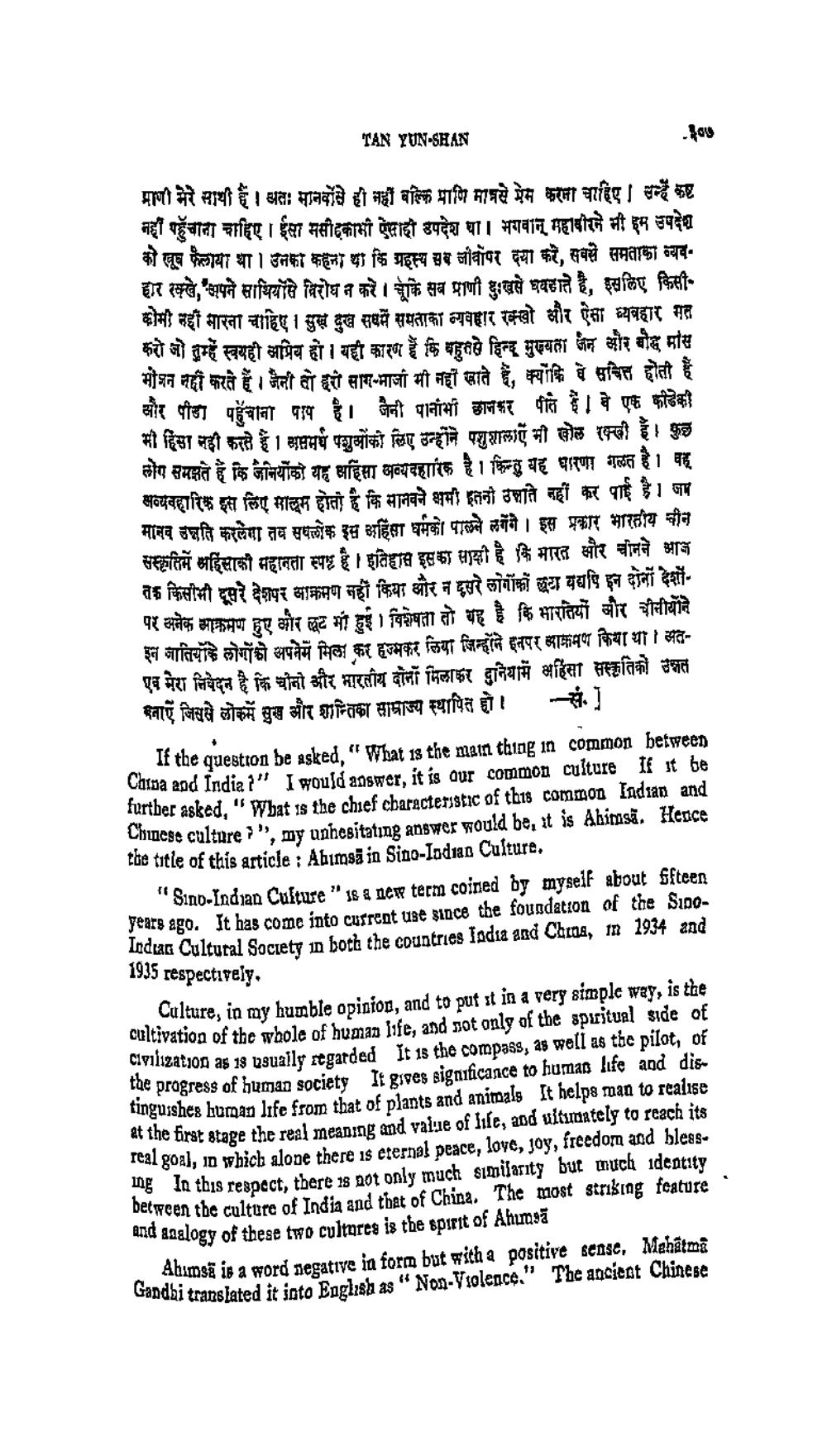________________
TAN YUN-SHAN
प्राणी मेरे साथी है। अत: मानवों ही नहीं बल्कि माणि मानसे मेम करना चाहिए। उन्हें कष्ट नहीं पहुंचाना चाहिए । ईसा मसीहकाभी ऐसाही उपदेश था। भगवान महावीरने भी इस उपदेश को खूब फैलाया था। उनका कहना था कि ग्रहत्य सब जीवापर दया करे, सबसे समताका व्यवहार रक्खे, अपने साथियोंसे विरोध न करे । कि सब प्राणी दुःखसे घबहाते है, इसलिए किसीकोमी नहीं मारना चाहिए । सुख दुख सधमें समताका व्यवहार रखो और ऐसा व्यवहार मत करो जो तुम्हें स्वयही अप्रिय हो । यही कारण हैं कि बहुत से हिन्द मुख्यता जैन और बौद्ध मांस भोजन नहीं करते हैं। जैनी वो इरो साम-माजी मी नहीं खाते हैं, क्योंकि चे सचित्त होती हैं और पीडा पहुँचाना पाप है। जैनी पानांभी छानकर पीत है। वे एक कोडेकी भी हिंसा नही करते हैं । असमर्थ पशुओंको लिए उन्होंने पशुशालाएँ भी खोल रखी है। कुछ लोग समझते हैं कि जनियोंको यह अहिंसा अव्यवहारिक है । किन्तु यह धारणा गलत है। वह अव्यवहारिक इस लिए मालम होती है कि मानवने शमी इतनी उचाते नहीं कर पाई है। जप मानव उन्नति करलेगा तब सबलोक इस अहिंसा धर्मको पालने लगेंगे। इस प्रकार भारतीय चीन संस्कृतिमें अहिंसाको महानता स्पष्ट है । इतिहास इसका साक्षी है कि भारत और चीनने आज तक किसीसी दूसरे देशपर आक्रमण नहीं किया और न दूसरे लोगोंको लूटा यद्यपि इन दोनों देशोंपर अनेक आक्रमण हुए और छूट भी हुई। विशेषता तो यह है कि भारतियों और चीनीयोंने इन जातियों के लोगों को अपनेमें मिला कर हमकर लिया जिन्होंने इनपर आक्रमण किया था। मतएव मेरा निवेदन है कि चीनो और भारतीय दोनों मिलाकर दुनियामें अहिंसा सस्कृतिको उन्नत मनाएं जिससे लोकमें सुख और शान्तिका साम्राज्य स्थापित हो। -स.]
If the question be asked, "What is the main thing in common between China and India?" I would answer, it is our common culture if it be furtber asked, "What is the chief characteristic of this common Indian and Chinese culture >', my unhesitating answer would be, it is Ahimsā. Hence the title of this article : Ahimsa in Sino-Indian Culture
"Sino-Indian Culture '18 a nete term coined by myself about ffteen years ago. It has come into current use since the foundation of the $100Indian Cultural Society in both the countries India and China, 1 1934 and
1935 respectively.
Culture, in my humble opinion, and to put it in a very simple way, is the ciltivation of the whole of human life, and sot only of the spujtual side of Civilization as 1s usually regarded It is the compass, as well as the pilot, of the progress of human society It gives significance to humas life and disfinguishes human life from that of plants and animals It helps man to realise at the first stage the real meaning and value of life, and uitunately to reach its real goal, in which alone there is eternal peace, love, joy, freedom and blesse ing In this respect, there 18 not only much similarity but much identity between the culture of India and that of China. The most striking feature end gaalogy of these two cultures is the spirit of Ahunasā
Ahimsa is a word negative in form but with a positive scose, Mahatma Gandhi translated it into English as " Non-Violence." The ancient Chinese




